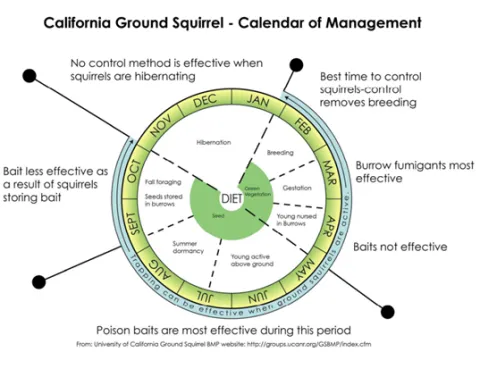California ground squirrel is the number one vertebrate pest in California. They are non-game mammals and can be controlled at any time, without a license, using any legal method. The Western gray squirrel is a tree squirrel classified as a fur bearing mammal and cannot be taken without a permit.
Biology
Ground squirrels are mottled brown with white markings on their backs. Their tails are less bushy than tree squirrels. They have a single litter of 5-8 young per year and are most active during the day, midmorning to late afternoon.
Ground squirrels hibernate in the winter, but in mild climates young may remain active.
They live in extensive burrow systems that can be destructive to property. The burrows range from 5 to 30 feet with 6 to 20 entrances. They prefer open habitats with scattered tress and ground cover. They like to dig adjacent to hardscape, raised beds, trees, stone or fences. The entrance holes are open with no soil plug.
Their diet changes with the seasons. In the spring, they feed on green grasses, herbaceous plants, and seedlings. As vegetation dries, they switch to eating seeds and grains in the summer and fall. They will feed on fruit, nuts, bark, twigs, and leaves. They can damage irrigation heads, tubing, and boxes. They forage near burrows, typically within a 75-yard radius.
Management
Understanding the ground squirrel life cycle is important when developing a management plan.

Exclusion – the best first step. Fencing needs to be secure and extend below ground with sections of slippery surfaces to be effective.
Fumigants - Unlike gophers, fumigants can work especially in high density situations in moist winter soil. Downsides include fire hazard and extreme non-target animal concerns. Fumigants will kill any animal in the burrow. They are most effective in winter or spring.
Predators- The level of control is suboptimal for the home gardener. Rattlesnakes are the number one predator of ground squirrels. Ground squirrels, especially the young, make up about 70% of the rattlesnake diet. Adult ground squirrels have impressive resistance to rattlesnake venom and have developed creative methods for battling this mortal enemy.
Trapping - best for low to moderate ground squirrel density.
Live traps - Live traps present a problem with squirrel disposal. In California, it is illegal to relocate a live-captured ground squirrel by moving it off your property without a permit. Drowning is illegal in California.
Place box traps or tunnel traps, containing food source, near burrows. For several days, do not set triggers on traps to allow squirrels free access to traps and food. Once they are accustomed to the traps set the trigger.
Disposal- Approved humane methods include shooting (only where legal) and use of CO2. See references.
Kill Traps – Tunnel trap -safe, easy to use; Conibear trap - placed in burrow opening, labor intensive, dangerous, non-target concerns, difficult to set. To avoid harm to non-target animals, spring all traps in evening and reset in morning.
Toxic baits - for high ground squirrel density
Only first-generation anticoagulants like diphacinone are available to homeowners. Must be used in tamper proof bait stations specific to ground squirrel control. It requires multiple feedings to be effective so less harm to non-target animals. Bait should never be available to non-target animals. Strictly follow product label. Most effective in summer and fall.
References
Euthanasia. Ground Squirrel BMPs. UC ANR. 2017. Euthanasia - Ground Squirrel BMPs - Ground Squirrel BMPs
Ground Squirrel Management for California. UC ANR. Ground Squirrel BMPs - Ground Squirrel Management for California
Headrick, David. 2022. Vertebrate Pest Management. Presentation to UC Master Gardeners of San Luis Obispo County, training class.
Feisty Squirrels Hold Clues to Treatment for Rattlesnake Bites. IET WebDev. 2020.UC Davis. Feisty Squirrels Hold Clues to Treatment for Rattlesnake Bites | UC Davis
Home and Landscape: Ground Squirrels. UC IPM. Ground Squirrel / Home and Landscape / UC Statewide IPM Program (UC IPM)
